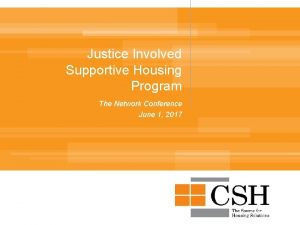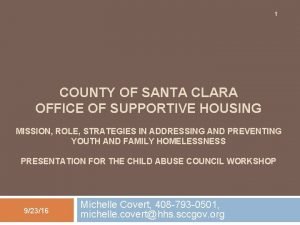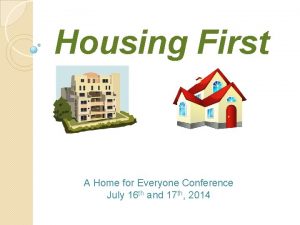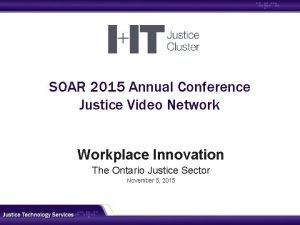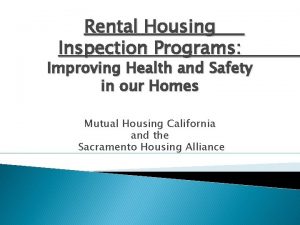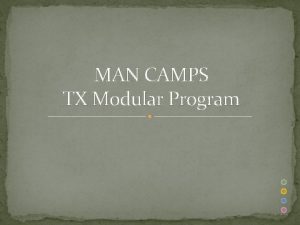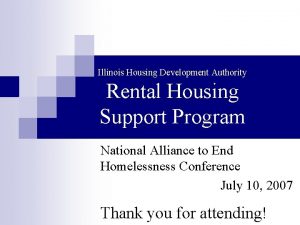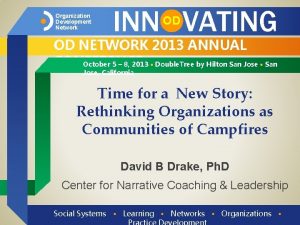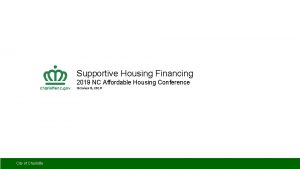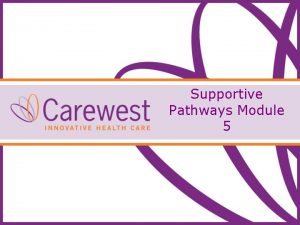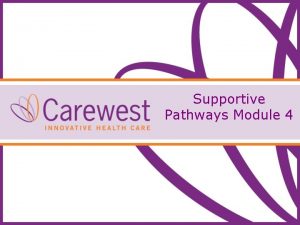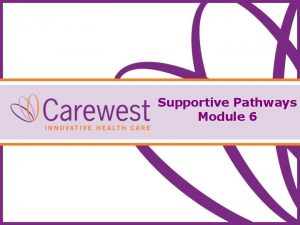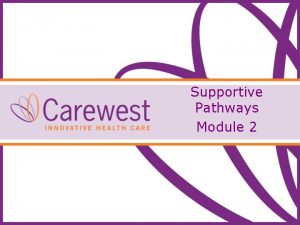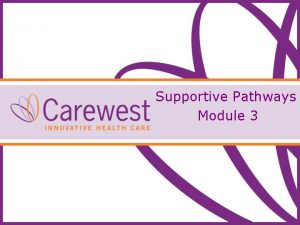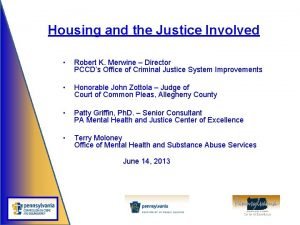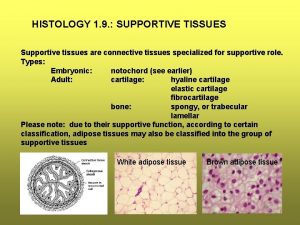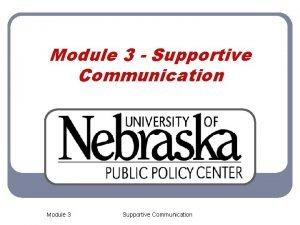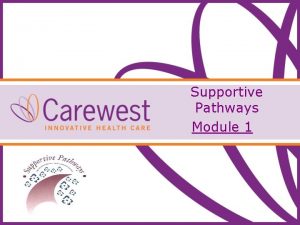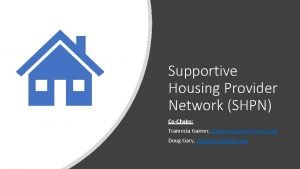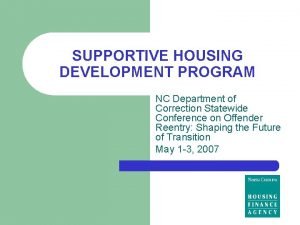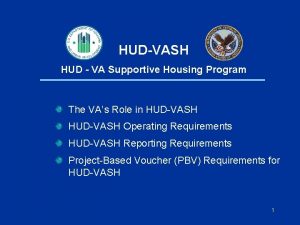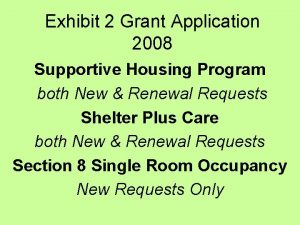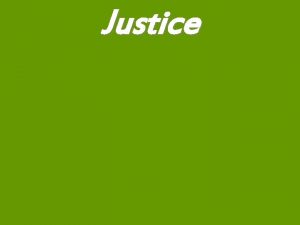Justice Involved Supportive Housing Program The Network Conference




























- Slides: 28

Justice Involved Supportive Housing Program The Network Conference June 1, 2017

§ Kristin Miller, CSH – Moderator § Jennifer Scaife, Mayor’s Office of Criminal Justice § Carolyn Slade, The Fortune Society § Angeles Delgado, LMSW, CAMBA § Ian Alcazar, Urban Pathways § Rebecca Sievers, Office of Housing, NYC Department of Health and Mental Hygiene (DOHMH)

Homelessness is an institutional circuit Drug Treatment Shelter Psych Center Jail Hospital Detox (IPT) Street Emergency Room

Breaking the Cycle “In order to end homelessness, we must reduce the number of people who enter the criminal justice system from homelessness and prevent homelessness among people leaving criminal justice settings. ” ~ USICH, August 2016

Supportive Housing for Frequent Utilizers (FUSE)

FUSE Evaluation

35 Communities Strong Hennepin Co FUSE King Co FACT Washtenaw FUSE/SIF Detroit FUSE Columbus BJA FUSE Lane Co. FUSE Planning KCC/SIF Denver FUSE Iowa City FUSE - Planning Pittsburgh FUSE Chicago FUSE Penn Place FUSE (Indy) Clark Co FUSE Planning Louisville ACT 10 th Decile Project Just in Reach 2. 0 Project 25 Rhode Island FUSE CT SIF Hudson Co NYC JISH FUSE Wash. DC FUSE Fredericksburg FUSE Richmond FUSE Meck. FUSE Maricopa Co FUSE Travis Co BJA Tarrant Co. FUSE Orlando Hospital FUSE Re-entry FUSE Health + Reentry focused FUSE Integrated Care for the Chronically Homeless Houston 1185 Program Palm Beach County FUSEPlanning Miami Coalition LIFT – Planning

THE MAYOR’S TASKFORCE ON BEHAVIORAL HEALTH AND THE CRIMINAL JUSTICE SYSTEM Jennifer Scaife, Mayor’s Office of Criminal Justice

Justice Involved Supportive Housing (JISH) targets individuals who continuously cycle through shelter, jail, and emergency room services. Supportive housing for justice involved people was a recommendation of the Mayor’s Task Force on Behavioral Health in the Criminal Justice System

Characteristics of JISH Clients • Tend to face low-level misdemeanor charges • Cycle through jail for short periods of time • Have significant behavioral health needs and extensive substance use • Struggle with homelessness • Tend to be older than the average jail population (47 years old on average)

Permanent supportive housing for this population has been shown to result in: • Fewer returns to jail: 40% reduction in days spent in jail and 38% reduction in jail admissions over two years • Less shelter use: 90% reduction in both shelter admissions and days in shelter over two years • Improved health outcomes: 55% reduction in days in a psychiatric hospital over two years

To date, 102 individuals have been housed through JISH Supportive housing saves the City an estimated $1. 5 million per year by reducing jail, shelter and crisis system use

Choosing JISH participants: data matching process • Step 1: MOCJ identified 400 individuals with at least 5 jail and 5 shelter admissions in any 4 -year period • Step 2: MOCJ randomly selected 200 individuals from original group of 400 for JISH – Those not selected for JISH serve as a randomized control group for evaluation purposes

Evaluation • MOCJ randomized eligible individuals into the program and comparison cohorts. MOCJ will use administrative and program data to determine whether the JISH program has an impact on – recidivism and related criminal justice outcomes – homelessness and service utilization – substance use and mental health • MOCJ may also explore whether the program has particular benefits for subgroups of participants (i. e. types of criminal histories or types of behavioral health needs)

Evaluation (cont) • • MOCJ will also engage an external research partner to conduct interviews and/or focus groups with program participants and program staff Purpose of these interviews/focus groups will be to gather data on how well the program is functioning, barriers to program performance, and suggestions for program improvement

Supportive Service Provider Role § § DOHMH assigns JISH referrals to one of three agencies § A Face-to-Face meeting is scheduled to complete a screening to determine client eligibility § Each client is assigned a Case Manager and Recovery Peer Specialist (CM & RPS) who ensure that the referent is enrolled into the JISH program through an intake process. Once client information received, outreach expected to be conducted within two business days

Supportive Service Provider Role § The referent housed in an apartment (can be single or shared) and is responsible for paying 30% of income to rent § Once housed, tenant meets with their CM and/or RPS minimum of 4 times a month § If needed tenant is linked to various services (mental health, PCP, substance TX, vocational, educational etc. ) within and outside participating organizations § Individualized Service Plans formulated with emphasis on housing, criminal justice involvement, substance use, mental health, social services

PROVISION OF SERVICES TO CLIENT Carolyn Slade The Fortune Society

Engaging Private Landlords and Realtors Angeles Delgado, LMSW Vice President, Health and Housing Services CAMBA

The Private Market Private market landlords are critical to the success of all scattered site housing programs. They play an important role in achieving the goal of ending homelessness in New York City. Therefore, developing strong and trusting relationship with landlords is critical not only to keeping current apartments, but also in obtaining and renting new ones. 20

The benefits to landlords who rent apartments to agencies Financial Benefits q Secure monthly rental payments q Replacement or payment for property damage covered in the lease q No financial loss due to having to evict tenants q Possible financial incentives (broker’s fee) Benefits of CAMBA Staff’s Oversight q Less interaction with our clients/tenants q Landlords have access to program staff if a problem arises q Landlords know that our clients are receiving ongoing case management services q CAMBA’s operational staff can make minor repairs q Less time spent resolving tenants’ problems 21

Engagement Strategies § Letters and calls introducing the agency and its services § Invite landlords/realtors to meet the team § Explain the process of renting to agencies, master leasing, and subleasing § Respond quickly and address tenants’ disruptive behaviors § Ask exiting landlords to recommend other landlords who may be interested in renting to the agency 22

Successes After lots of legwork, phone calls, and exploring new frontier, JISH has leased all 30 units. v In 2010, 90% of CAMBA’s supportive housing units were in Brooklyn. v With JISH, CAMBA established new relationships with landlords in the Bronx. 26 units (87%) are in the Bronx 4 units (13%) are in Brooklyn JISH Housing Units Leased 35 30 25 20 15 Units 10 5 0 Start date 10/15/15 6 -months 3/15/16 12 -months 10/15/16 23 18 -months 4/1/17

Challenges § De-stabilization of affordable housing. Non-profits do not have rent stabilization protections. § Competing with other non-profits and regular renters for a limited pool of apartments. § High cost of housing and limitations on rental amounts. § As demand has increased, so has rental cost. Landlords have become more selective. Although landlords do not say it, they reduced the number of apartments they rent to agencies or “programs. ” This had a significant impact on the number of units and the quality of those units. § Apartments could be in multiple boroughs, which increases staff response time or a client’s travel time to the office. § “Program buildings”- buildings which have multiple agencies renting a % of the building until a large # of the total units are rented to “programs. ” § Landlords offering poorly maintain buildings. § Walk-up units in higher floors without an elevator. 24

Lessons Learned § Strike out into new areas and boroughs. § Seek to develop strong working relationships with landlords renting apartments to your program. Responsiveness to their concerns is important and helps this. § Look for staff with experience in housing and with identifying apartments and working with landlords. § Train staff on doing outreach to landlords/realtors and promoting the benefits of renting to agencies. 25

Government Partner Engagement Ian Alcazar, Urban Pathways 26

JISH Outcomes Rebecca Sievers, MA, MPA Senior Program Specialist, DOHMH, Office of Housing Services 27

Q&A Contact Information: Kristin Miller: kristin. miller@csh. org Jennifer Scaife: jscaife@justice. nyc. gov Carol Slade: cslade@fortunesociety. org Angeles Delgado, LMSW: Angelesd@camba. org Ian Alcazar: ialcazar@urbanpathways. org Rebecca Sievers, DOHMH: rsievers@health. nyc. gov
 Fortune society scattered site housing
Fortune society scattered site housing Santa clara county office of supportive housing
Santa clara county office of supportive housing Supportive housing providers association
Supportive housing providers association Nc affordable housing conference
Nc affordable housing conference Housing first partners conference
Housing first partners conference Justice video network
Justice video network Juvenile justice alternative education program
Juvenile justice alternative education program Single family housing section 504 repair pilot program
Single family housing section 504 repair pilot program City of sacramento rental housing inspection program
City of sacramento rental housing inspection program Hano housing choice voucher program
Hano housing choice voucher program Georgia housing voucher program dbhdd
Georgia housing voucher program dbhdd Single family housing guaranteed loan program
Single family housing guaranteed loan program Modular man camps
Modular man camps Illinois rental housing support program
Illinois rental housing support program Fdic affordable housing program
Fdic affordable housing program Od network
Od network Infor ion bi
Infor ion bi Hát kết hợp bộ gõ cơ thể
Hát kết hợp bộ gõ cơ thể Bổ thể
Bổ thể Tỉ lệ cơ thể trẻ em
Tỉ lệ cơ thể trẻ em Voi kéo gỗ như thế nào
Voi kéo gỗ như thế nào Tư thế worm breton là gì
Tư thế worm breton là gì Alleluia hat len nguoi oi
Alleluia hat len nguoi oi Các môn thể thao bắt đầu bằng tiếng nhảy
Các môn thể thao bắt đầu bằng tiếng nhảy Thế nào là hệ số cao nhất
Thế nào là hệ số cao nhất Các châu lục và đại dương trên thế giới
Các châu lục và đại dương trên thế giới Công thức tính thế năng
Công thức tính thế năng Trời xanh đây là của chúng ta thể thơ
Trời xanh đây là của chúng ta thể thơ
